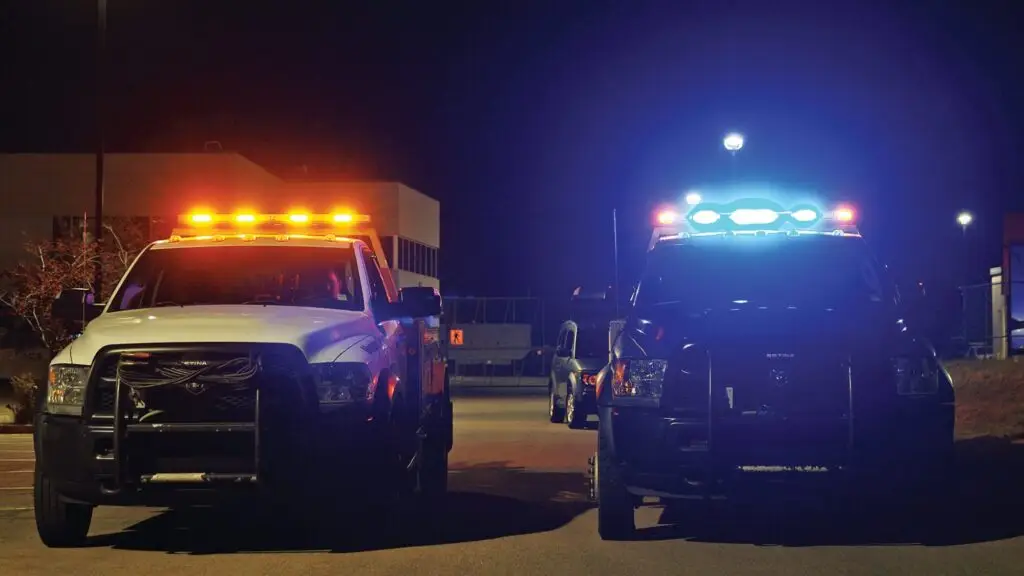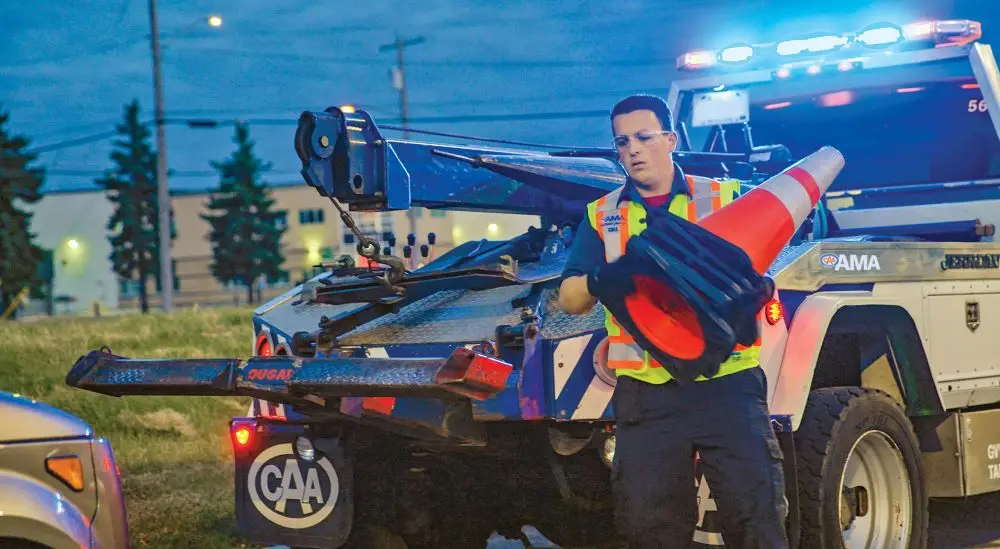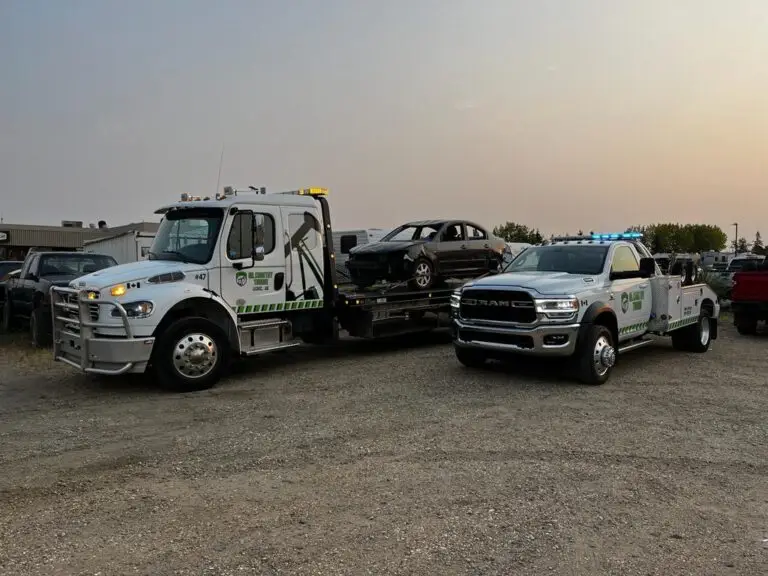The goal of the Registrar’s Exemption under the Traffic Safety Act was to increase roadside safety for tow and recovery operators. Did it work?
by Kara Cunningham
June 30, 2023, marks the one-year anniversary of the blue lights pilot project in Alberta, a program that allows tow and recovery operators in the province to use flashing blue and amber lights on their vehicles while working roadside. Bill 207: The Traffic Safety (Tow Truck Warning Lamps) Amendment Act was a private members’ bill introduced in April 2022 by former police officer Brad Rutherford, MLA for Leduc-Beaumont.
The purpose of Bill 207 was to help increase roadside safety for industry professionals. The Towing and Recovery Association of Alberta (TRAA) and the Alberta Motor Association (AMA), along with other key stakeholders, had been advocating for regulatory change for years.1 Given many members of TRAA are also AMA contractors, it made sense to work together. The AMA represents about 80% of all private passenger tows that take place in the province, and the association operates its own fleets in both Edmonton and Calgary.2
Bill 207 didn’t advance beyond the first reading; however, the government did sign a Registrar’s Exemption under the Traffic Safety Act, which is an authority of government under the Act. “This is a huge step forward in making our industry safer for roadside assistance workers and the motoring public through increased visibility,” said Don Getschel, owner/operator of Oil Country Towing and president of TRAA. “The effectiveness of this change will be noticeable and will save Albertans’ lives.”3
But did the adoption of blue lights actually make a difference? Studies certainly suggested that it would. In a recent Tow Canada interview, Jeff Kasbrick, vice president, advocacy and operations at the Alberta Motor Association (AMA), shared the results of industry research:
“There’s an incredible degree of science behind flashing lights and the colours associated with them. The AMA poured significant amounts of research into this and found a couple of things. First, multiple colours of light flashing together are far more effective and visible than a single colour alone. And Alberta tow trucks were limited to only flashing amber lights. Second, when we look at the most effective colour combinations, particularly in low light and inclement weather conditions, the most effective was blue and amber.”
So one year into the program, can we say that the blue lights pilot has been successful? According to Getschel, the unmitigated answer is YES:
“As the weeks and months started to go by—what a difference! We went from about 30% compliance with people slowing down to about 90% compliance after switching to blue lights. I couldn’t believe the difference it made. I can safely say we haven’t had any serious incidents with our trucks since.”
Along with Getschel, the AMA also reports measurable results: “What we saw immediately was it created a change in driving behaviour,” said Kasbrick. “Drivers were able to make that distinction at the side of the road and respond more positively to blue and amber lights. And in conjunction with the body of research that was already out there, this has helped affirm that this change was the right thing to do.”
Tow Canada met Kevin when he arrived at Carter Cadillac in Burnaby, B.C. Transporting the pod safely to a dealership was only the first part of Kevin’s job. He parked his tow truck n
“We’ve been hearing a lot from our tow operators, as well as the partners we work with, that motorists are responding when there are blue flashing lights. Since December 2019, there have been at least 17 serious roadside incidents and at least 39 near misses involving Alberta tow trucks and passing vehicles, and we didn’t see as many vehicle strikes this past year as we have in the past,” said Kasbrick.
For Getschel, his experience with the pilot has simply confirmed that blue lights save lives: “I truly believe that this is the case. I’ve seen the difference it makes for us working on one of the busiest corridors in our province, on the highway, that shot between the airport and the city limits of Edmonton which sees the most traffic. This is where we work every day.”
Getschel also gave an example of how blue lights can inform driving behaviour, affirming the research that blue light is highly visible in low light and inclement weather: “I’ve been to a couple of collision scenes where, rolling up, I can see their blue lights before I see anything else—they’re off in the distance, and I’m about five kilometers back, and I can see well. I can see their lights, and I have plenty of time to slow down and adjust my driving when I get up close to move past them.”
And how has the public responded? According to Getschel, Alberta motorists approve: “The public is just blown away by it. They like it. They said that they can see us better in the rain, they can see us better in the fog, and they can see us better in the snow, and 90% of the time we are working in those three weather conditions.”
An AMA survey also indicated community-wide support. “We have nearly a million members within the province,” said Kasbrick. “We have a touch point in one out of every three households, and we reached out to ask who had seen a tow truck with blue and amber lights: 86.9% of those members indicated their support. They indicated that the blue and amber combination provided more visibility at the side of the road.”
On February 28, 2023, the tow and recovery community of Alberta received even more good news: the government announced that it was extending the blue lights program for another five years, to February 29, 2028.4
Initially some towing companies were reluctant to make the investment of blue lights on their trucks, given the program began as a one-year pilot. With this extension, however, it is likely that more companies will make the leap. As stated by Kasbrick:
“The five-year period was an important part of securing buy-in from tow companies. That’s why we asked the government to provide long-term certainty that this wasn’t something that was going to be revoked, so industry operators could make the investment in blue lights for their own safety. But beyond that guaranteed five-year period, we have every confidence that this change will become permanent.”
ext to the dealership’s building, and from the moment he jumped out of his cabin, he started the transformation of the pod into a real showroom.
Using hydraulic power, the pod expanded from its original eight feet to 16 feet-wide on the truck’s bed. Kevin then lowered a hydraulic strut from each corner of the pod to support the whole construction. Once the hydraulic legs were secured on wooden blocks, the pod was lifted even further, above the tow truck’s deck. By standing on the struts, Kevin was able to drive the flat bed away from the pod. In the final step, the supports were gradually retracted, bringing the container to the ground.
It was an impressive sight to witness the pod transformed into a shiny showroom in less than two hours. After completing final touch-ups to set up the interior of the showroom, Kevin’s job was done. He had a day and a half of free time to explore the beautiful city of Vancouver and get some rest. After, he returned to the dealership to perform the same drill, this time in the opposite order, before heading to the farthest dealership on Vancouver Island. “This is like a vacation,” joked Kevin, a level 8/9 certified WreckMaster, who knows how to take the most out of this “on the road” lifestyle.
Author’s note: Thank you, Kevin, for inviting Tow Canada to document this stop on your journey across Canada and allowing us to take a sneak peek at this all-electric luxury SUV.
“We knew that this was the right thing to do for the safety of our tow operators and the Albertans that they’re responding to.”

Getschel recalls a brutal accident in 2018 when an operator for Oil Country Towing was struck while doing his job at the side of the highway and is still suffering from both physical and psychological trauma as a result of the incident:
“I just think you can’t put a price on safety, and that’s one thing that my business partner, Kristy Fairs, and I agreed on from the start,” said Getschel. “When the use of blue lights was approved, I said to her, ‘You know this is going to cost us a lot.’ And she said, ‘I don’t want to get another phone call [that a tow operator has been injured or killed]. I don’t want to get that phone call ever again.’”
AMA’s Kasbrick says it’s about every Albertan’s right to a safe workplace: “It’s been a very long road to get to this point, but we knew that this was the right thing to do for the safety of our tow operators and the Albertans that they’re responding to. It could be tomorrow that it’s one of our family members stranded on the side of the road. This is a simple change that will truly save lives.”
According to Getschel, the implementation and success of the blue lights program in Alberta is not only a huge win for provincial towing and recovery professionals, but also for operators across Canada. Getschel thinks it is only a matter of time before their use spreads nationwide: “I just want tow operators across Canada to be safe out there while they’re doing their jobs,” he said.
Getschel and Kasbrick both reflected on the benefits of working together to achieve a common goal.
Kasbrick said: “One of the pieces that was essential to our success was working with like-minded stakeholders to help amplify our collective voices, and this is one of those circumstances where we’re greater than the sum of our individual parts.”
The AMA’s work to secure approval for blue lights included outreach and collaboration with many safety stakeholders, including the Alberta Motor Transport Association (a commercial trucking association) and the Alberta Chiefs of Police.
“We showed them the research behind our recommendation and, as we would fully expect from our partners in safety and law enforcement, they recognized the compelling evidence and were fully supportive.”
Getschel would also like to acknowledge the media that supported the blue lights initiative: “I’d like to give a special shout-out to Global Edmonton reporter Sarah Ryan and Alison MacKinnon of CTV News Edmonton. They were such advocates for our cause and gave our voice an audience, and we needed that. There were others as well.”
When we look at the most effective colour combinations, particularly within low light and inclement weather conditions, the most effective was blue and amber.”
So what is next?
In September, there will be further changes to Alberta traffic laws to increase roadside safety for tow operators. All vehicles travelling in the same direction will be required to slow to 60 km/h and to move over if they can. This will also apply to single-lane travel in both directions. According to Kasbrick, Alberta’s Slow Down, Move Over legislation does not currently require motorists to actually move over, so what seems like a small change could actually make a huge impact to tow operators’ safety.
Tow Canada will continue to report on future program developments. If you have an experience or perspective to share related to Alberta’s blue lights pilot or the province’s Slow Down, Move Over legislation, please contact the publisher at publish@ara.bc.ca.
1 “Alberta Tow Trucks Allowed to Use Blue Lights Under Pilot Project.” (July-August 2022). TowCanada.ca
2 Interview: Kasbrick, J. (May 16, 2023). Tow Canada.
3 Alberta Government. (June 10, 2023). “Pilot Project to allow blue lights on tow trucks.” Government of Alberta. Retrieved June 2, 2023.
4 Alberta Government. (February 28, 2028). “Registrar’s exemption: installation and use of blue flashing lamps on tow trucks and support vehicles.” Government of Alberta. Retrieved June 2, 2023.


